Mirada, medios, memoria




“Desconfiar de las imágenes…”


Cierre de Fuego Inextinguible:
62. WORKER: I’m a worker and I work in a vacuum-cleaner factory. My wife could use a vacuum cleaner.
63. WORKER: That’s why I take one part with me every day. At home I want to put together the vacuum cleaner, but no matter what I do, it always turns into a submachine gun.
65. STUDENT: I’m a student, and right now I work at a vacuum-cleaner factory, but I think that the factory is making submachine guns for the Portuguese. But we could really use some proof.
66. STUDENT: That’s why I take one part home with me every day. At home, I want to put the gun together, but no matter what I do, it always turns into a vacuum cleaner.
68. ENGINEER: I’m an engineer and I work for an electrical corporation. The workers think we’re making vacuum cleaners. The students think we’re making submachine guns. This vacuum cleaner can become a useful weapon. This submachine gun can become a useful household gadget.
69. ENGINEER: What we manufacture depends on the workers, students and engineers.








Es necesario recrear la realidad, porque la realidad huye, la realidad niega la realidad
Minh-ha



“Meaning can neither be imposed nor defined. Although every film is in itself a form of ordering and closing, each closure can defy its only closure, opening onto other closures, thereby emphasizing the interval between apertures and creating a space in which meaning fascinated by what escapes and exceedes it” TMH
“Yet such illusion (the quest for meaning) is real; it has its own reality, one in which the subject of knowledge, the subject of Vision, or the subject of meaning continues to deploy established power relations, assuming Himself to be the basic reserve of reference in the totalistic quest for the referent, the true referent that lies out there in nature, in the dark, waiting patiently to be unveiled and disciplined correctly: to be redefined. Perhaps then, an imagination that goes toward the texture of reality is one capable of playing upon the illusion in question and the power it exerts” TMH

“The documentary mode is a transnational language of practice. Its standard narratives are recognized all over the world and its forms are almost independent of national or cultural difference. Precisely because they operate so closely on material reality, they are intelligible wherever this reality is relevant (..) A transnational documentary jargon is now connecting people within global media networks. The standardized language of newsreels, with its economy of attention based on fear, the racing time of flexible production and hysteria, is as fluid and affective, as immediate and immersive as Vertov could have imagined. It creates global public spheres whose participants are linked almost in a physical sense by mutual excitement and anxiety. Thus the documentary form is now more potent than ever; it conjures up the most spectacular aspects of the language of things and amplifies their power” (Steyerl, 2008)

LA ESCRITURA COMO MONTAJE
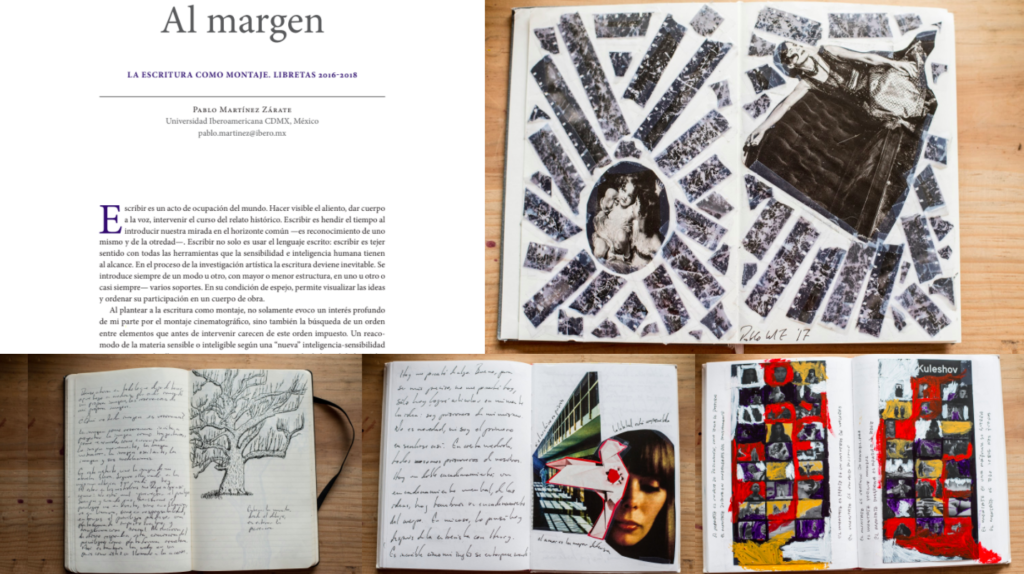


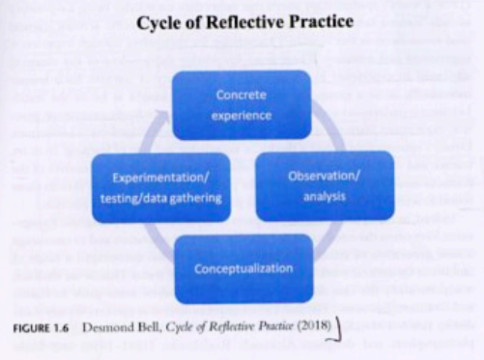 Ciclo de práctica reflexiva — experiencia concreta – observación/análisis – conceptualización – experimentación/testeo/registro —
Ciclo de práctica reflexiva — experiencia concreta – observación/análisis – conceptualización – experimentación/testeo/registro —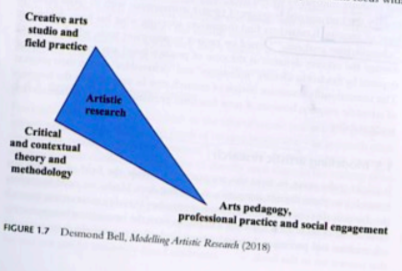 modelando la investigación artística
modelando la investigación artística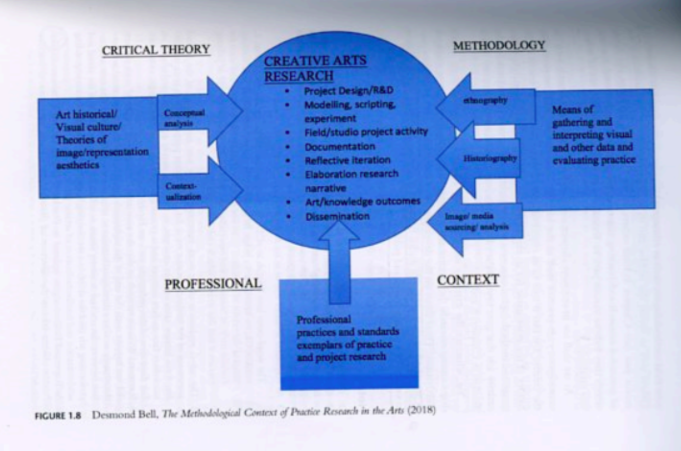
Investigación artística
Toda práctica es un posicionamiento. En el posicionamiento, desplegamos dinámicas de poder (ser, hacer, sentir, pensar).
Steyerl: arte y ocupación

Al pensar la ética, me remito a las resonancias de nuestros actos de ocupación en el mundo. ¿Cómo desplegamos nuestra práctica, qué estrategias y tácticas nos guían?
La ética en el documental en general, y en el documental latinoamericano en particular, de pronto parece vivir en una encrucijada. Las imposiciones de la denuncia, por ejemplo, y los modos establecidos de la misma, serían una de las formas.

Me gusta pensar que hay una correspondencia entre la ética y la estética, que “todo gesto estético es un gesto ético”.
Algunas implicaciones ético-estéticas de la práctica documental en su sentido expandido:
- Ocupación de las herramientas, los códigos, los espacios y los tiempos de la experiencia
- Posicionamiento directo o indirecto en una tradición, en una memoria de la propia práctica
- Vinculación con un contexto histórico y sus agentes
- Incidencia en los horizontes del archivo y la memoria colectiva
- Resonancias con lo no-humano

La creación parte una de necesidad de expresión: ¿Qué quiero decir? ¿Cómo puedo decirlo?







“La investigación temática, que se da en el dominio de lo humano y no en el de las cosas, no puede reducirse a un acto mecánico. Siendo un proceso de búsqueda de conocimiento, y por lo tanto de creación, exige de sus sujetos que vayan descubriendo, en el encadenamiento de los temas significativos, la interpretación de los problemas” (Freire, 1970: 134).
“La síntesis cultural no niega las diferencias que existen entre una y otra visión sino, por el contrario, se sustenta en ellas. Lo que sí niega es la invasión de una por la otra. Lo que afirma es el aporte indiscutible que da una a la otra” (Freire, 1970: 239).





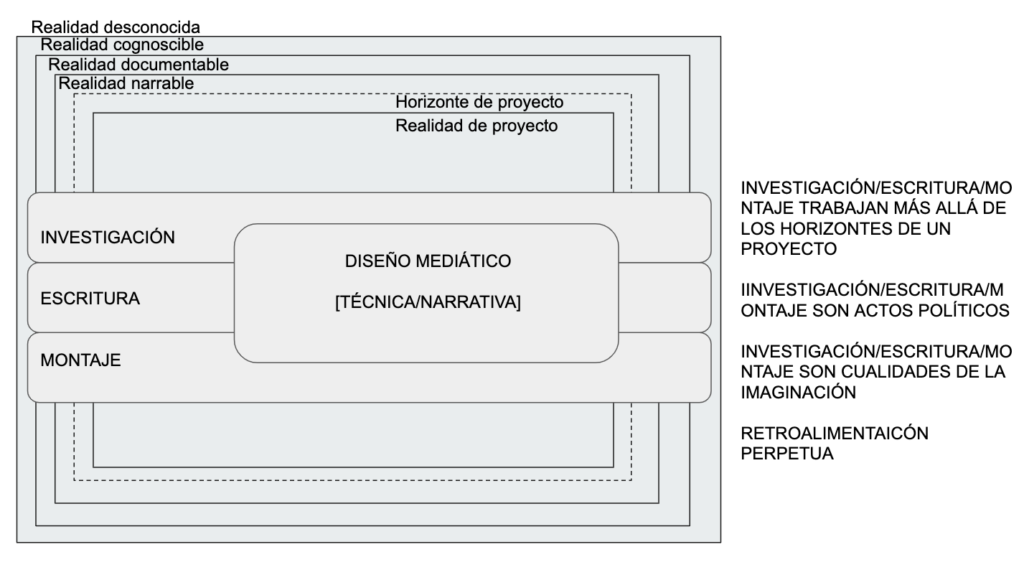
Algunas ideas que surgieron también de esta misma presentación
Realidad como exceso, arte como exceso
Máquinas de guerra como principio de diseño (poética de la información)
Cronografía y topografía para un arte documentalMontaje como intensidad y extensión
Investigación (existencia), escritura (experiencia) y montaje (expresión)
Pensamiento transmedia
Diseño modular:
El principio modular, identificado por Manovich como uno de los “principios de los nuevos medios” (Representación numérica, Modularidad, Automatización, Variabilidad, Transcodificación).
Universo Narrativo: todo el conjunto u horizonte de nuestro discurso, en este caso pedagógico (qué daremos, cómo, dónde)
Módulos Narrativos: cada uno de los bloque o módulos de la experiencia, es decir, las etapas de la experiencia
Unidades Narrativas: los elementos específicos que irán articulando la experiencia en el día a día
Conjunciones (iteraciones): variaciones y despliegues de las investigaciones